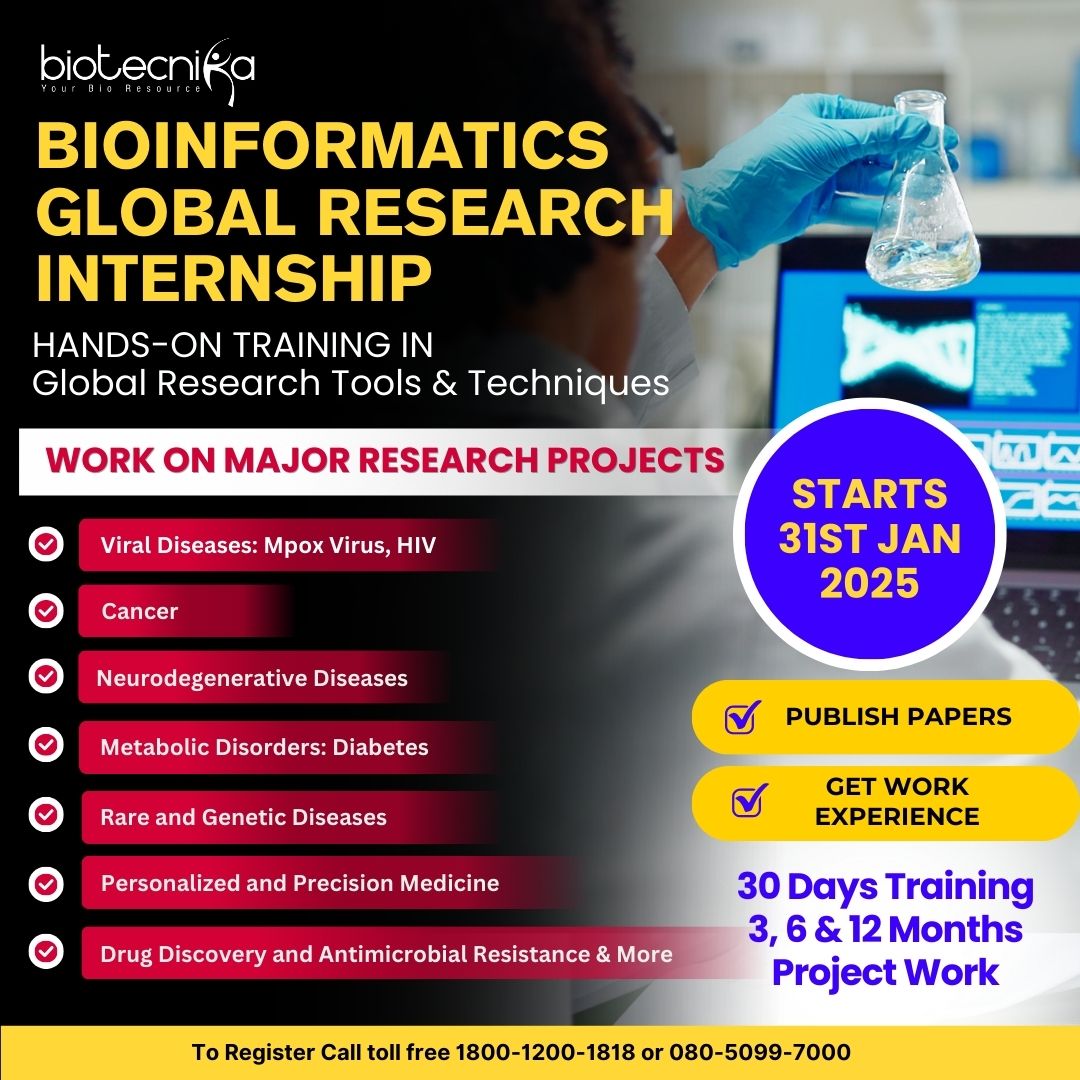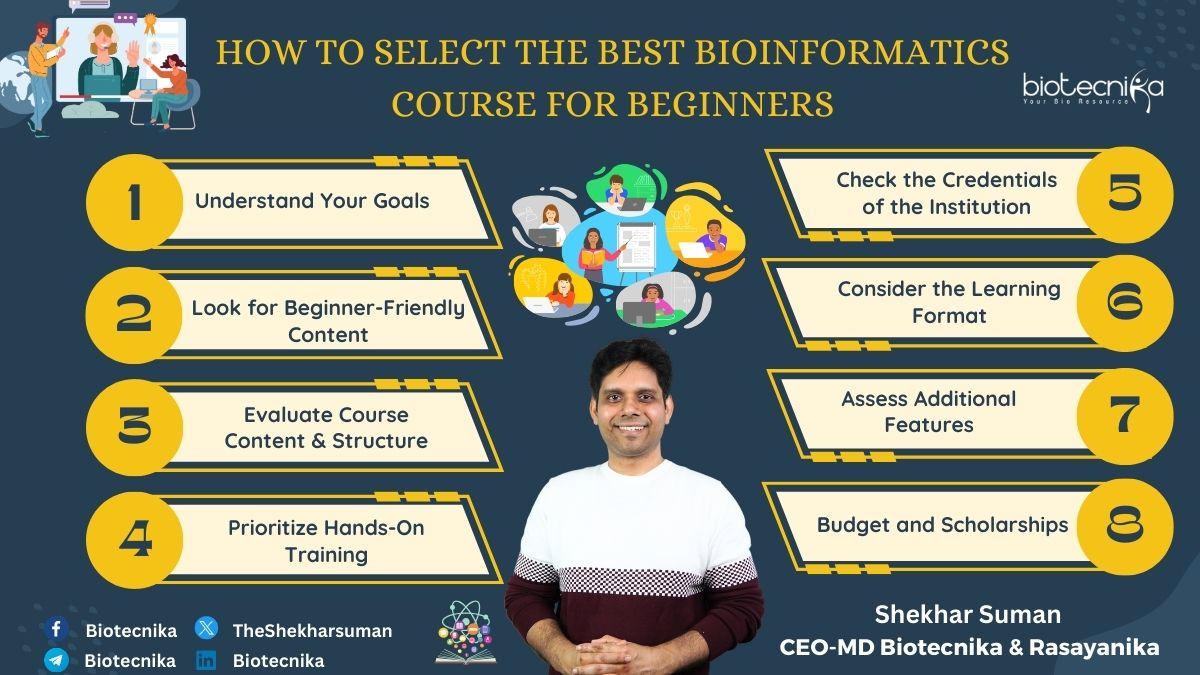How to Choose the Best Bioinformatics Course for Beginners
Bioinformatics is one of the emerging and rapidly evolving fields in the life science sector. With its interdisciplinary approach, it combines biology, computer science, and data analysis, and this field offers countless career opportunities. However, it can be overwhelming for beginners who want to choose the right course to start their career in bioinformatics. This field has a wide range of topics, and selecting a course that fits your interests can be challenging.
This article on How To Choose Best Bioinformatics Course? will act as a comprehensive guide & will help you understand all factors to consider while selecting a bioinformatics course and help you make the best choice.
Table of Contents
1. Understand Your Goals
Before diving into the field of bioinformatics courses, it’s important to understand a few basic questions.
- Why do you want to learn bioinformatics? Are you interested in a career in academic research, industry, or a clinical setting? Understanding your long-term goals will help you focus on the course offerings most relevant to your career aspirations.
- What is your academic background? Depending on your prior knowledge, choose a course that provides foundational knowledge or one that gives in-depth knowledge on specialized topics.
- What skills are you focusing on developing? The Bioinformatics field involves many different areas, such as programming, data analysis, genome annotation, and machine learning. Identifying specific skills will help you in learning programming languages as well as working with large biological datasets.
Being clear about your goals will help you narrow down course options that align with your specific needs and aspirations. This will help you select the right course structure and gain the depth of knowledge that matches your learning objectives.
2. Look for Beginner-Friendly Content
As a beginner, it’s important to select a course that doesn’t overwhelm you or will expect you to have prior technical expertise in the field. Look for courses that:
- Deal with the basics of bioinformatics & slowly progresses to advanced concepts– In simple, accessible terms.
- Cover fundamental concepts such as sequence alignment, genome analysis, biological databases (like GenBank and BLAST), and how these tools are applied in real-world bioinformatics research.
- Provide both theoretical and practical knowledge – Make sure you will not only learn the underlying concepts but also able to gain hands-on experience for basic understanding. A will design basic course will give you precise, easy-to-learn lessons that will gradually build your bioinformatics skills.
3. Evaluate Course Content and Structure
The best bioinformatics courses for beginners should provide a well-rounded foundation in the field. Look for the following essential topics:
- Introduction to Bioinformatics: A brief overview of the field, including the basics of genomics, proteomics, and computational biology. This will give you basic over view as well as understanding more advanced topics.
- Programming Skills: This filed involves working with large datasets as well as automating the analysis process. Looking for courses that gives you basic programming languages such as Python, R, or Perl will be beneficial, especially if you don’t have any prior coding knowledge.
- Database Management: It’s important to understand how bioinformatics databases are organized and accessed. Learning to navigate tools like BLAST or GenBank will be invaluable as you progress in your studies.
- Applications of Bioinformatics: The course should provide practical examples of how bioinformatics is used in real-world applications, such as drug discovery, personalized medicine, and evolutionary studies. This can help you gain an appreciation for the practical utility of bioinformatics tools.
4. Prioritize Hands-On Training
Bioinformatics is a highly practical field, and theoretical knowledge alone is insufficient. Choose courses that emphasize hands-on experience through:
- Live projects or case studies: Real-world projects will help you apply what you’ve learned in a meaningful way and give you experience working with actual bioinformatics data.
- Access to real-world datasets: Choose a course that offers access to large databases and allows you to practice data analysis, enabling you to gain familiarity with the types of problems you will face in a professional life.
- Mentorship: Mentorship from experienced professionals can be invaluable. Look for courses that provide guidance from instructors or industry experts to help you navigate practical challenges.
5. Check the Credentials of the Institution
The reputation of the institution offering the course is crucial to ensure that you’re getting a quality education. Make sure that the course is:
- Designed by experienced bioinformaticians: Look for instructors who have practical, real-world experience in the field, as well as academic credentials.
- Industry-oriented: A course should prepare you for real-world challenges and applications, not just theoretical knowledge. Courses that include practical applications in bioinformatics are essential for entering the workforce.
- Up-to-date: Bioinformatics is an ever-evolving field. Ensure that the course material is updated to reflect the latest advancements in technologies, tools, and trends
6. Consider the Learning Format
All students have different learning patterns, so ensure the course you choose fits your preferred learning style. Some standard formats include:
- Live Sessions: Select the platform that provides you with interactive classes where you can interact with your mentors and ask questions in real time. This platform is ideal for students who prefer direct interaction.
- Recorded Lectures: Learn at your own pace, watching pre-recorded sessions. This is great if you need flexibility to fit learning around other commitments.
- Workshops: Intensive, short courses focused on specific bioinformatics tools or topics. Ideal for getting a deep dive into a particular subject.
- Mentorship: Find a course that provides you access to mentorship or industrial connections. This will be a valuable resource when navigating your career.
Biotecnika offers a combination of these formats, ensuring that learners can choose the option that best suits their preferences and schedules.
7. Assess Additional Features
While evaluating bioinformatics courses on different platforms, choose a course that will provide additional benefits and also that can enhance your learning experience.
- Access to resources: Some online platforms provide additional materials, such as e-books, software tools, and practice datasets, which can significantly enhance your understanding.
- Certifications: Choose the course from reputed institutions so that you can get a course of completion certificate. This will add value to your resume and also help in job applications.
- Placement Assistance: Some institutions offer guidance on job applications, interviews, and internship opportunities. This can be a valuable support system as you transition from learning to employment.
Why Choose Biotecnika for Bioinformatics?
Biotecnika has been a trusted name in the BIO-IT Field and the life sciences community for 
Here are some beginner-friendly bioinformatics courses offered by Biotecnika:
- Bioinformatics Global Research Tools & Techniques Hand-on Training & Internship Programs – Starts from 31st Jan 2025
- Focus Area: This internship provides practical training in bioinformatics tools and techniques as well as software for advanced research and development.
- Suitable for Both beginners & experienced
Key Features:
-
-
- Hands-on training with real-world datasets.
- Both online and offline learning options are available.
- Work on 3,6 & 12 Months of project work
- Publish papers, get work experience & recommendation letter
- Get trained in cutting-edge Bioinformatics tools
- Live projects to build industry-ready skills.
- This global research tools and technique course starts on the 31st of January 2025 with a limited seat.
-
2. Bioinformatics Certification Course
-
- Focus: This course offers a comprehensive introduction to bioinformatics, covering essential topics like sequence alignment, database tools, and data analysis techniques.
- Key Features: Hands-on training, practical sessions, and introductory-level content tailored for beginners.
3. Python for Bioinformatics
-
- Focus: This course teaches Python programming with an emphasis on bioinformatics applications.
- Ideal For: Beginners who have no prior coding experience but wish to learn how to use Python for bioinformatics tasks such as data analysis and automation.
3. Next-Generation Sequencing (NGS) Data Analysis Course
-
- Focus: This course offers practical exposure to data processing as wee
- This course provides training in NGS workflows and tools, offering practical exposure to data processing and analysis.
- Key Features: In-depth understanding of the NGS process, from data acquisition to analysis, with access to real datasets.
4. Molecular Docking and Drug Discovery Course
-
- Focus: This course covers the application of bioinformatics in drug discovery, focusing on protein-ligand interactions and docking simulations.
- Key Features: Real-world examples from pharmaceutical research and hands-on experience with docking tools.
5. Genome Editing and CRISPR Technology
-
- Focus: Learn about genome editing techniques like CRISPR and their bioinformatics applications in research.
- Key Features: Both theoretical and practical training to help you understand CRISPR research and its applications in gene therapy and biotechnology.
Budget Friendly Scholarships
Finally, ensure the course fits within your budget. Biotecnika offers competitive pricing, along with scholarships and discounts, making high-quality education accessible to a broader audience. Be sure to check if there are financial aid options that can help reduce the cost of your studies.
As a beginner, it is very important to choose the right bioinformatics course. Firstly, it may seem challenging but with the proper guidance, your path can be both motivating and challenging too. By choosing a beginner-friendly course along with hands-on experience from well-known institutions such as Biotecnika can build your solid foundation to thrive in this dynamic and rapidly growing field.
Start your journey from today onwards and unlock the potential of bioinformatics to shape the future of life sciences!
How To Choose the Best Bioinformatics Course?
FAQs
1. What is Bioinformatics, and why should I learn it?
Answer: Bioinformatics is an interdisciplinary field that combines biology, computer science, and data analysis to understand biological data, especially genomic data. Learning bioinformatics is crucial because it opens doors to various career opportunities in research, healthcare, and biotechnology. It allows you to contribute to advancements in areas such as personalized medicine, drug discovery, and genetic research.
2. Do I need a background in biology or computer science to take a bioinformatics course?
Answer: While having a background in biology or computer science can be helpful, it is not required for all bioinformatics courses. Many beginner-friendly courses are designed to teach foundational concepts in both biology and computer science, making them accessible to learners from diverse academic backgrounds. However, some courses may assume basic knowledge of either field, so it’s essential to choose a course that matches your current skill level.
3. What programming languages should I learn for bioinformatics?
Answer: The most commonly used programming languages in bioinformatics are Python, R, and Perl. Python is particularly popular due to its simplicity and versatility, making it ideal for beginners. R is often used for statistical analysis and data visualization in bioinformatics. Perl, while older, is still used for certain data-processing tasks. Many bioinformatics courses offer programming lessons tailored to the field, especially in Python and R.
4. How important is hands-on practice in a bioinformatics course?
Answer: Hands-on practice is mandatory in bioinformatics. The field relies heavily on working with real biological datasets and using bioinformatics tools to analyze and interpret data. Courses that include practical assignments, live projects, and access to real-world datasets will help you gain the experience needed to apply theoretical knowledge in real-world scenarios. Without hands-on practice, it can be difficult to grasp bioinformatics concepts fully.
5. Does Biotecnika Provide Jobs after completing the Bioinformatics Course?
Answer: Biotecnika provides 100% job assistance after you have completed the training program with us and have qualified for the exam at the end of the course. If you have opted for project work, you will get paper publication assistance, Work experience letter & recommendation with 12 months of project work. For any queries regarding the bioinformatics hands-on internship, please mail to [email protected] or call TOLL FREE – 1800-1200-1818
How To Choose the Best Bioinformatics Course?







































